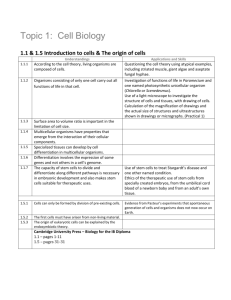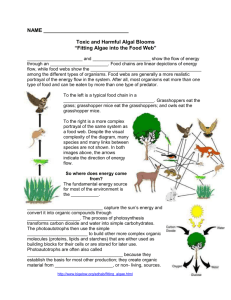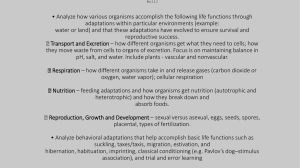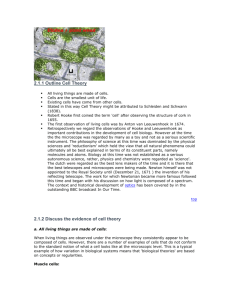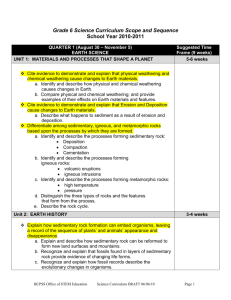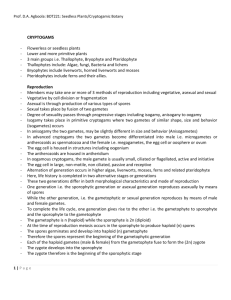File
advertisement
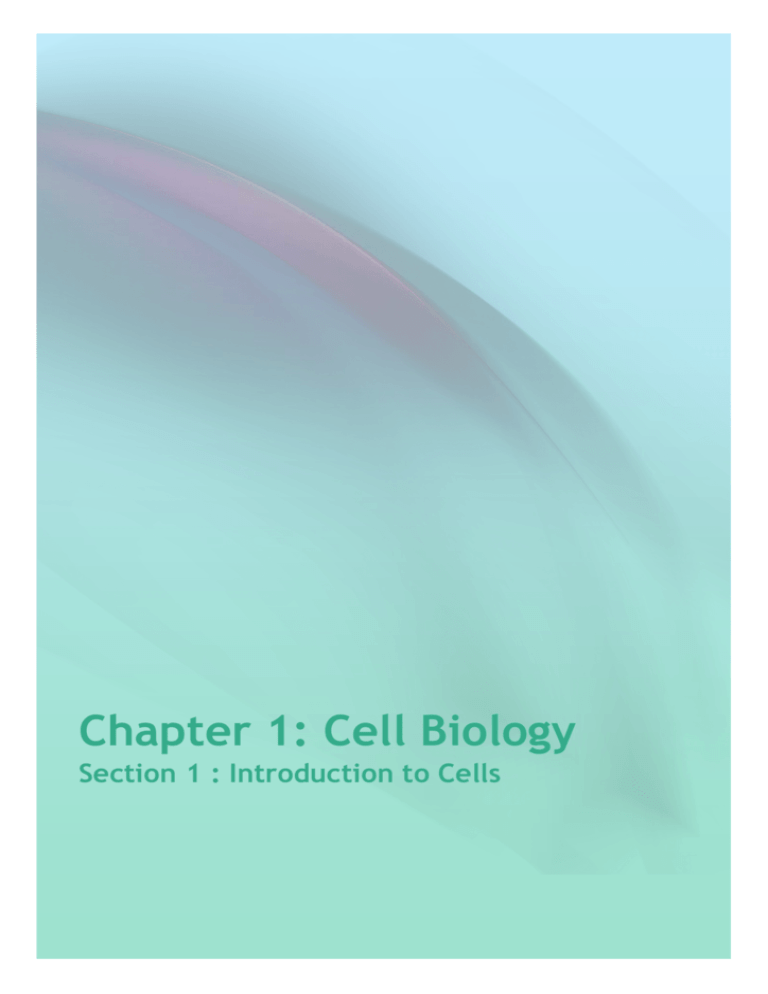
Chapter 1: Cell Biology Section 1 : Introduction to Cells 1.1.U1: According to cell theory, living organisms are composed of cells 1. State the three core ideas of cell theory: I. All living things are composed of cells (or cell products) II. The cell is the smallest unit of life III. Cells may only arise from pre-existing cells 2. What evidence supports the idea that living organisms are composed of cells? I. Living organisms are an individual form of life II. Organelles are a differentiated structures within a cell, that carry out different functions III. Cells multiply by mitosis or meiosis 1.1.A1: Questioning the cell theory using atypical examples, including striated muscle, giant algae and aseptate fungal hyphae 1. For each atypical example outline how it challenges conventional cell theory a. Striated muscle: Have more than one nucleus per cell (sometimes more than 100) Muscle cell fibres can be very long (30mm) The muscle fibres are surrounded by a single plasma membrane but they are many-nucleated ⇒ The size of the cell and the fact that it has many nuclei doesn’t conform to the idea of cell theory that a cell has to be small and be single-nucleated b. Giant algae: Extraordinarily big Very simple in structure especially compared to other plant cells Most algae are made up of a single huge cell ⇒ Algae are gigantic in size with a simple structure, opposing the idea that cells (the most basic unit of life) has to be microscopic and relatively complex in structure c. Aseptate fungal hyphae: A fungi is composed of thread-like structures called hyphae Each hypha is an uninterrupted tube-like structure with many nuclei spread along it ⇒ In fungal hyphae the cells seem to be merged rather than divided, thus producing a bigger single-cell, which contradicts the parameters of a cell according to cell theory 1.1.U2 Organisms consisting of only one cell carry out all functions of life in that cell 1. State the functions of life as demonstrated by all living organisms The web of all enzyme-catalysed reactions in a cell or organism (e.g. respiration) Metabolism Responses Homeostasis Growth Reproduction Excretion Nutrition Respond to and interact with the environment Maintenance and regulation of internal cell conditions (e.g. water and pH levels) Living things can grow or change size/shape Removal of metabolic waste Produce offspring, either sexually or asexually Feed by either synthesis of organic molecules (e.g. photosynthesis) or absorption of organic matter 1.1.A2 Investigation of functions of life in a Paramecium and one named photosynthetic unicellular organism Paramecium A small unicellular living organism Belong to the kingdom of Protista About 0.5mm long (unless someone has super eyesight, microscope needed to study and view them) Famous for their predator-prey relationship with Didinium Known for their avoidance behaviour - If given an obstacle or negative stimulus, it is capable of rotating up to 360 degrees in order to “escape Has an oval – slipper shape - Rounded at the front/top - Pointed in the back/bottom Chlorella A type of single-celled algae Spherical in shape About 2-10μm in diameter Famous for its rapid, photosynthetic reproduction Paramecium Chlorella Nutrition: Eats small bacteria by driving them into the gullet though the oral groove, which acts as a mouth (phagocytosis) Doesn’t make own food so has to move around and find it Metabolism: Eat to stay alive, to keep sugar and food levels up, thus energy levels up Response: Respond to food since they move towards their prey (algae, bacteria, etc.) and then engulf it Respond to negative stimuli and obstacles by rotation up to 180 degrees and “escaping” They can communicate by weak electromagnetic radiation Use cilia to move Homeostasis: Contractive vacuole controls water levels and is filled with it (storing it up for when necessary) Growth: They grow and maintain different sizes Reproduction: They can divide both sexually and asexually, however they prefer asexual reproduction, yet under stressful conditions they can sexually Excretion: Release waste through cytoplasm and cell membrane Nutrition: They are green in colour thus it can be inferred that they use chlorophyll to break down glucose through photosynthesis Metabolism: The food goes into the cytoplasm when released from the chloroplast to be broken down Response: They react to light since they need light for food, thus they move towards what they think will give them food (sunlight) Homeostasis: Water is stored in the small vacuole(s) that look like bubbles Growth: They grow and maintain different sizes Reproduction: They reproduce asexually Excretion: Release waste through cytoplasm and cell membrane 1.1.U4 Multicellular organisms have properties that emerge from the interaction of their cellular components Emergent properties: tungsten, metal cup, wires, glass container, etc. Final Product: Light bulb 1. Unicellular organisms carry out the functions of life, multi-cellular organisms differentiate and show emergent properties a. Outline, giving two specific examples of advantages of cells differentiating to carry out a specific function Example 1: Rod Cell A rod cell is located in the retina of the eye It absorbs light and transmits the impulses that that light gives to the brain (coded colour waves) thus allowing humans to see in certain colours Example 2: Red Blood Cells A red blood cell is located in the blood Its main job is to transport oxygen to different parts of the body for respiration ⇒ Cell differentiation is crucial since it allows cells in a tissue to carry out their function more efficiently since they can develop the ideal structure, with the enzymes needed to carry out all of the chemical reactions associated with the function. 1.1.U5 Specialized tissues can develop by cell differentiation in multicellular organisms 1.1.U6 Differentiation involves the expression of some genes and not others in a cell’s genome 8. All cells in an organism share the same, identical genome (i.e. they all posses the same genetic material). In which type of cells is the entire genome active and why? Stem cells have the entire genome activated due to the fact that when an animal egg is fertilized, it is very simple and has few cells, but in order to develop into a full grown fetus the few cells must have the possibility of differentiation in order to carry out different functions such as breathing, moving, etc. 1.1.U7 The capacity of stem cells to divide and differentiate along different pathways is necessary in embryonic development and also makes stem cells suitable for therapeutic uses 9. Describe what is ment by the term stem cells The name stem cell was given to the zygote (a fertilized ovum) and the cells of an early embryo, thus wanting to say that all the tissues of the adult stem from those cells. 10. Describe how newly formed cells become specialized. When a cell specializes, it acts out to perform a specific function with specific genes. The genes not used are switched off, and once they are switched off they will remain like that unless triggered by a catalyst.
